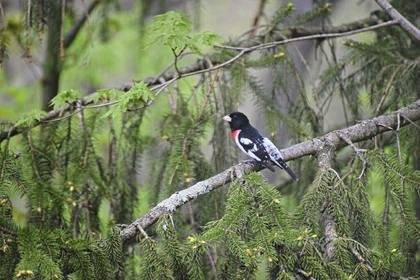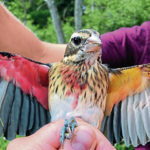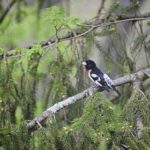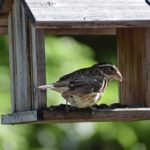Bird banders in Cook Township banded a one-in-a million bird — a rose-breasted grosbeak with half its body looking like a male and the other half, a female.
The bird was banded on Sept. 24 at Carnegie Museum of Natural History’s Powdermill Nature Reserve bird banding station in Westmoreland County.
The find is roughly one record per million birds banded, said Danny Bystrak, a wildlife biologist with the U.S. Geological Survey’s birding lab at Patuxent Wildlife Research Center in Laurel, Md.
This grosbeak certainly looks quite different from the others. Typically, male grosbeaks sport a blood red chevron on a white chest, flanked by dramatic black and while plumage. The female is more subdued with brown and white plumage, and looks like like a large, fancy sparrow.
The Powdermill grosbeak, an immature, has a line running roughly down its middle with male feather colors on the right and female colors on the left, according to a Powdermill press release. It has the male pink “wing pits,” breast spot and black wing feathers on the right side and the female yellow wing pits and browner wing on the left side.
One Powdermill researcher likened the experience to seeing a unicorn, said Annie Lindsay, bird banding program manager at Powdermill. “The entire banding team was very excited to see such a rarity up close, and are riding the high of this once-in-a-lifetime experience.”
Known as “gynandromorphs,” such birds have both male and female feather coloration. There have been a number of recent reports, including a gynandromorph cardinal in Erie that created a stir, said Daniel Hopper, a postdoctoral research scientist at Columbia University in New York.
He questions if the Powdermill grosbeak will be able to keep a mate or reproduce. Apparently, the bird’s appearance and behavior could send the wrong signal to the other grosbeaks.
A well-studied gynandromorphic zebra finch “exhibited male-typical courtship behavior (singing and courting when housed with a female) but was attacked when housed with a normal male,” Hopper said.
Although the Powdermill bird might have functional ovaries, it would “likely pair with a female if it sings and otherwise acts like a male,” he noted.
An emerging national leader in avian research, the Powdermill Avian Research Center evaluates and disseminates best practices for novel technologies to track birds, contributes to management recommendations for at-risk species and populations, and studies the effects of habitat and species loss on migrating birds.













